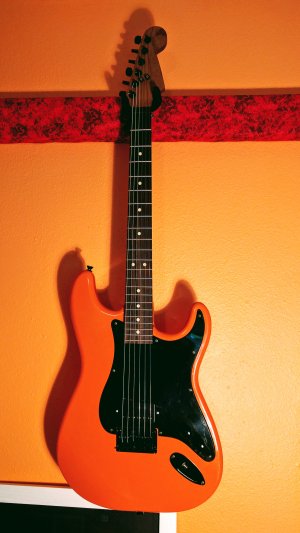EddieDavis
Junior Member
- Messages
- 101
Some of y'all have helped me with tips on this Frankensquire project, now fitted with a new Warmoth neck, Schaller tuners, and a BKP holy diver (which is totally sick by the way!).
It's still a work in progress, new pickguard tomorrow and nut slots worked on by my guitar tech in about a week, and beyond that I have two issues I'm hoping to solve.
One, my bridge intonation screws are knocking my guitar out of tune. Two - after all the time and money spent, I find myself really wishing this guitar had a whammy. Thinking I might kill two birds with one stone... You know where this is going :headbanging:
I know what most people will say to replace the body with a new one that is routed for the tremolo bridge you want. I've heard that side and I get why people say it, so no need to repeat this advice!
What I'm hoping to hear about is if anyone has had experience with actually rerouting a hardtail Fender style body for tremolo use... And if so what was your experience? Did you notice a tonal difference for better or worse? Did you experience any challenges or setbacks?
Also if you were going to do it, is there a trem you recommend for a successful surgery? I'd rather not change my nut so probably not looking to convert to a double locking system, although I'm a big fan of fine tuners.
Anyone who's done a hardtail to tremolo conversion on a strat, I'd love to hear from you!
Oh and finally, I should add I would be getting this done professionally.
It's still a work in progress, new pickguard tomorrow and nut slots worked on by my guitar tech in about a week, and beyond that I have two issues I'm hoping to solve.
One, my bridge intonation screws are knocking my guitar out of tune. Two - after all the time and money spent, I find myself really wishing this guitar had a whammy. Thinking I might kill two birds with one stone... You know where this is going :headbanging:
I know what most people will say to replace the body with a new one that is routed for the tremolo bridge you want. I've heard that side and I get why people say it, so no need to repeat this advice!
What I'm hoping to hear about is if anyone has had experience with actually rerouting a hardtail Fender style body for tremolo use... And if so what was your experience? Did you notice a tonal difference for better or worse? Did you experience any challenges or setbacks?
Also if you were going to do it, is there a trem you recommend for a successful surgery? I'd rather not change my nut so probably not looking to convert to a double locking system, although I'm a big fan of fine tuners.
Anyone who's done a hardtail to tremolo conversion on a strat, I'd love to hear from you!
Oh and finally, I should add I would be getting this done professionally.



